Abstract
The bonding of cement mortar to the concrete substrate is crucial in buildings. In this study, cement mortar was prepared using manufactured sand (MS) instead of river sand (RS). The bonding strength between manufactured sand mortar (MSM) and concrete substrate was evaluated and the effects of curing age, water-to-cement ratio (w/c) and thermal cycling on the bonding strength were discussed and compared with those of the river sand mortar (RSM). The compressive strength of the MSM was consistently higher than that of the RSM, while the bonding strength of RSM was consistently higher than that of MSM, indicating that the bonding strength does not depend on the compressive strength of the mortar. As the number of thermal cycles increased, the pull-off strengths at the interface between the concrete and MSM or RSM at different w/c ratios all decreased, and the RSM experienced a larger reduction. After 400 cycles, the percentage decrease in bonding strength of MSM sample ranged from 18.62% to 30.86%.
1. Introduction
The external wall structures of a building usually consist of three main components: concrete substrates, mortar and tiles [1]. Generally, the factors that affect the stability of the building exterior wall structure include the shrinkage deformation of adhesive materials, mismatch of thermal expansion between materials, weathering problems and invasion of chemical pollutants [2,3,4,5,6]. From field observations, the interfacial transition zone (ITZ) between mortar and concrete substrates is the most vulnerable part of the external wall structure [7]. Some studies have been conducted on the shear stress, interface resistance and bonding strength of the ITZ for external wall structures with different types of mortar [5,6,7,8,9,10]. Due to long-term thermal expansion causing differential movement among the material layers, shear stress is one of the main causes for the fading of external wall tile structures [1,11]. Differential thermal expansion and contraction within a wall section due to the heat of hydration can also cause thermal cracking [12]. The external wall tile structures are exposed to an external environment that suffers a severe weathering effect. Bochen [13] found that there was a great decrease of bonding strengths for the mineral plaster (61.5%) and lime-sand plaster (37.7%) under a weathering effect.
Nowadays, river sand (RS) is used as a fine aggregate to produce adhesive mortars, which are widely used in external rendering and internal finishing. However, the limited supply of RS and the adverse impact of dredged RS on the environment may lead to increased costs and delays in construction projects. To minimize this environmental problem and meet the goal of sustainable development, researchers have conducted studies on river sand alternatives, focusing on the possibility of artificially grinding aggregate particles to a smooth shape in order to increase the packing density and workability of fine aggregate [14,15,16,17,18]. This kind of fine aggregate is called manufactured sand (MS). MS is a product of rock fragmentation, and its characteristics are determined by the parent rock structure and the fracture mode, etc. [19]. Therefore, the shape, gradation and physical properties of MS are different from those of RS, which have an important influence on the workability and mechanical properties of concrete [15,17,20,21,22]. In addition, the rheology and viscosity of the mortar and the durability of the concrete are closely related to the particle characteristics of the fine aggregate [17,23]. When the w/c is the same, the mortar with MS may have a lower workability compared with the mortar prepared with RS due to the angular particle properties [24,25].
MS has been widely used as a substitute for RS in recent years [23]. However, there are few studies on the use of MS as a plastering mortar for exterior wall structures and the effects of weathering on its application. It is worth noting that due to the special particle characteristics and physical properties of MS, the workability of manufactured sand mortar (MSM) is different from that of river sand mortar (RSM), and the bonding properties of ITZ between concrete substrates and cement mortar with MS are unclear. This study explored the effects of w/c, curing age and weathering on the bonding strength of cement mortar and concrete substrates. In addition, using RS as a model for comparison, the influence mechanism was also analyzed to discuss the possibility of MS application in mortar used in external wall structures. This is of practical significance for expanding the application range of MS, reducing construction costs and developing green buildings.
2. Materials and Methods
2.1. Particle Size Analysis of MS and RS
The compressive strength of concrete strongly depends on the particle size distribution of the aggregate [26]. Due to its production process, MS has the characteristics of smaller strain stiffness, lower density and higher critical state friction angle [19]. However, the irregular shape of MS can provide a better interlocking structure and improve the strength of the concrete [27]. In addition, different particle size distributions and surface characteristics of the sand affect the workability under the same w/c conditions [28,29].
The MS was dried for 24 h at a temperature of 105 ± 5 °C. The sieves were cleaned using brushes and arranged in the correct order. The particle size distribution of the MS and the RS were compared and analyzed, and the results are shown in Figure 1. Line C, M and F are the classification limits of the fine aggregate according to the CS3:2013 standard [30]. Figure 1 shows that the particle size distribution of RS is mainly concentrated in the range of 0.3–1.18 mm, and the RS with a particle size within this range accounts for about 90% of the total mass. Compared with RS, the particle size of the MS is more evenly distributed in the range of 0.063–5 mm. According to Figure 1, the MS can be classified as Grade M, and the sand with a particle size below 0.15 mm accounts for 7.315% of the total mass, which is much higher than the standard Grade C and M. The results indicate that the MS satisfies the corresponding limit classification range, and it can be inferred that the MS has a higher bulk density when preparing the cement mortar.
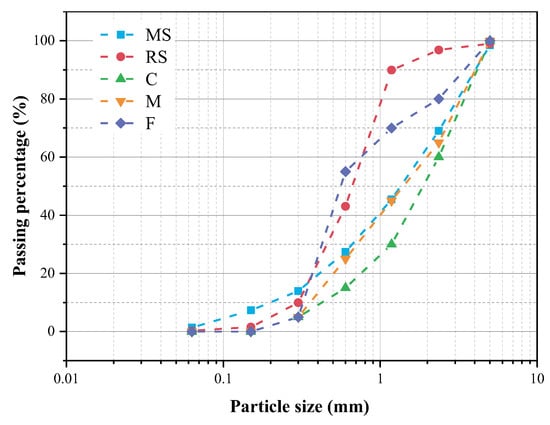
Figure 1.
Particle size distribution of MS and RS.
2.2. Mix Proportion of Concrete Substrates and Mortar
The mix proportion of concrete substrates is shown in Table 1. Allowing sufficient time for the drying and initial shrinkage of the concrete substrate contributes to the formation of a higher bonding strength. Due to the relatively small size of the concrete substrate and the time span of the research, two weeks were reserved for the initial shrinkage of the concrete substrate in this experiment.

Table 1.
Mix proportion of concrete substrate.
In addition, the mortar with two w/c (0.42 and 0.50) was applied and the ratio of cement to sand was 1:3. The mix proportion of mortar is shown in Table 2. The Buildings Department of Hong Kong has issued a Practice Note for Registered Contractors, with rev. in 2013, stating that the total thickness of the coating should not be greater than 20 mm and the thickness of each coating should be in the range of 8 mm to 16 mm. This standard is the same as the British Standard (BS EN 13914-1:2016). In this research, the thickness of the MSM and RSM was set to 15 mm. The prepared samples were demolded after 24 h and placed in a standard maintenance room to cure for various lengths of time (0, 3 and 7 days).

Table 2.
Mix proportion of mortar.
2.3. Thermal Cycling Experiment
Thermal cycle testing was used to simulate the weathering environment in which building exterior wall structures are located. The thermal cycle testing was performed by freezing the specimens to 0 °C for 30 min in a fridge and then thawing them to 25 °C over 30 min. In addition, the thermal cycling was repeated manually by turning the fridge on and off, and each set of specimens were tested after undergoing 0 (no thermal cycles), 100, 200, 300 and 400 thermal cycles.
2.4. Compressive Strength Test
RSM and MSM cube samples with a volume of 100 × 100 × 100 mm were prepared according to the ratio in Table 2. Mechanical properties of hardened mortar samples were tested according to the standard GB/T50107-2010.
2.5. Pull-Out Test
The proper adhesion between the layers of external wall structures has an important effect on durability. In order to measure the bonding strength between the concrete wall substrate and the mortar, the pull-off test is necessary. Bond strength is the maximum applied tensile strength that causes the cracking of the mortar on the surface of the concrete substrate [31]. The defined pull-head plate was bonded to a defined area of the mortar surface and then subjected to a vertical tensile load for measurement. The bonding strength is determined using the following Formula (1) [32] where fu and Fu stand for the bonding strength (N/mm2) and failure load (N), respectively. A represents the cylindrical test area to which tensile stress is applied (mm2).
The concrete substrate was cured for two weeks and the surfaces of the concrete substrate were pre-wetted with water before applying the fresh mortar. A layer of mortar with a thickness of 15 mm was placed over the surface of concrete substrates. The prepared samples were demolded after 24 h and placed in a standard maintenance room to cure for various lengths of time (0, 3 and 7 days). After different numbers of thermal cycles (100, 200, 300 and 400 cycles), the experimental samples were cut into a circular area of about 50 mm in diameter at the mortar layer by a core drilling machine, and the cutting depth required to penetrate the interface and enter the concrete substrate by 5 mm is shown in Figure 2a. A cylindrical metal plate (50 mm in diameter) was then glued onto the area using an epoxy adhesive (bonding strength between epoxy adhesive and concrete ≥ 10 MPa), as shown in Figure 2b. Depending on the expected bonding strength, the stress load should be applied at a constant speed and impacts are avoided in the range of 0.003 to 0.010 N/ (mm2·s).
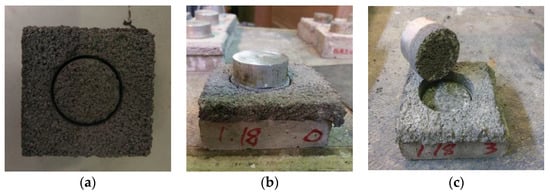
Figure 2.
Pull-off test: (a) groove of 50 mm diameter and 5 mm deep, (b) cylindrical metal plate glued to the surface of the test sample and (c) fracture surface of a sample after pull-out test.
Figure 3a shows a schematic diagram of the pull-off test sample and three possible fracture modes with valid results shown in Figure 3b–d. The fracture modes shown in Figure 3b,c are two kinds of cohesion fracture that occur inside the mortar or concrete substrate, which indicates that there is no failure between the interface of the mortar and concrete substrate, and the result should be considered to be the lower limit. The fracture mode shown in Figure 3d is an adhesive fracture and the fracture occurs at the interface between the cement mortar and concrete substrate. When this type of fracture occurs, the obtained data represent the adhesion that causes the mortar layer to detach from the concrete substrate [33].

Figure 3.
(a) Simplified schematic of pull-off test; three different failure modes during the pull-off test: (b) fracture surface is inside the mortar, (c) fracture surface is inside the concrete and (d) fracture surface is at the interface between concrete and mortar.
3. Results and Discussion
3.1. Compressive Strength of MSM and RSM
Figure 4a shows that the compressive strengths of MSM and RSM with 0.42 w/c are all higher than those of MSM and RSM with 0.50 w/c. Specifically, when cured for 7 days, the compressive strength of MSM with 0.42 w/c reached 48.63 MPa, which is 16.12% (about 6.75 MPa) higher than that of MSM with 0.50 w/c. The compressive strength of RSM with 0.42 w/c at 7 d is 42.97 MPa, which is 5.71% (2.32 MPa) higher than that of RSM with 0.50 w/c. When the curing age is 28 d, the compressive strength of MSM with 0.42 w/c increased to 60.25 MPa, which is 19.07% (about 9.56 MPa) higher than that of MSM with 0.50 w/c. The compressive strength of the RSM with 0.42 w/c at 28 d is 59 MPa, which is 10.38% (5.55 MPa) higher than that of RSM with 0.50 w/c. These results show that the higher the w/c, the lower the concrete strength, which follows the normal behavior of strength development [34], and the w/c has a greater impact on the MSM than the RSM. In addition, when the w/c and curing age are the same, the compressive strength of MSM is always higher than that of RSM. The irregular shape of MS could provide a better interlocking structure and improve the strength of concrete [20,28,35,36], which can be used to explain the results of this experiment.
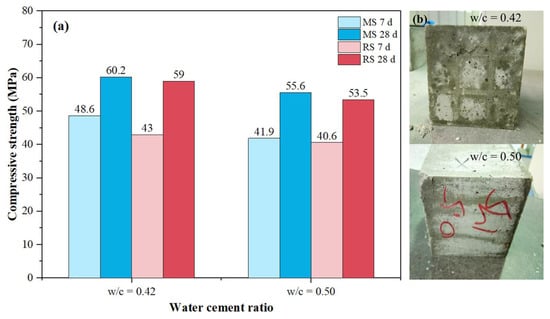
Figure 4.
(a) Compressive strength and (b) failure patterns of MSM cubes.
As shown in Figure 4b, vertical cracks can be observed on the surfaces of all MSM and RSM cubes with a w/c of 0.42 and 0.50. The cracks are nearly equal in size, with little damage to the contact face between the cube and the compressive testing machine. This indicates that the cubes had an even surface and resisted the loading evenly; therefore, the experimental results are effective.
Studies have shown that a lower w/c results in the poorer workability of the fresh mortar, while a higher w/c results in lower mortar strength [20]. Although the strength is slightly lower, the mortar with 0.50 w/c samples has a higher workability than that with 0.42 w/c, so the mortar can be easily applied to the concrete substrate. On the other hand, despite the higher strength, it may be more difficult to establish good chemical properties between mortar with 0.42 w/c and the concrete substrate due to the relatively poor processability. Therefore, in this study, two kinds of w/c (0.42 and 0.50) were used to prepare the MSM and RSM for the pull-out test to investigate the effect of the water-cement ratio on bonding strength.
3.2. Bonding Strength of MSM and RSM
3.2.1. Influence of Curing Age and Water-Cement Ratio on the Bonding Strength of MSM and RSM
The effect of curing time on the bonding strength at the interface between the different kinds of mortar and the concrete substrate is shown in Figure 5. When the curing age and the number of thermal cycles were certain, the pull-off strength of the sample prepared according to the w/c of 0.42 is higher than that of the sample with 0.5 w/c. When the curing time is 0 days and the number of thermal cycles is 0, the pull-off strength at the interface between the concrete substrate and MSM with 0.42 w/c is 2.04 MPa. When the w/c is increased to 0.5, the pull-off strength is reduced by about 13.46% to 1.76 MPa. In contrast, the bonding strength of RSM decreased 5% from 2.6 MPa to 2.47 MPa. It’s reported that the increase in w/c ratio will reduce the bonding strength and increase the workability of the cement mortar [37]. With an increase of the number of thermal cycles, the pull-off strength at the interface between the MSM, RSM and concrete substrate with a w/c of 2 all decreased by varying degrees, while the pull-off strength with 0.42 w/c was always higher than the strength when the w/c is 0.5. In addition, when the curing time was 3 and 7 days, the pull-off strengths had a similar development trend. Therefore, it can be concluded that the higher the w/c, the lower the bonding strength. Therefore, it can be determined that MSM with 0.42 w/c would provide a stronger bonding strength and an MSM with 0.50 w/c would provide an acceptable strength with a higher workability; this information guided the preparation of mechanical mortar in the project.
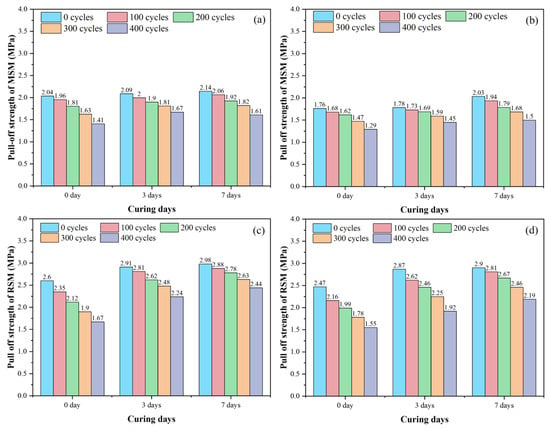
Figure 5.
The effect of different curing times on pull-off strength of MSM with (a) 0.42 w/c and (b) 0.50 w/c and RSM with (c) 0.42 w/c and (d) 0.50 w/c.
Figure 5 shows that the bonding strength is subjected to early curing conditions. Obviously, under the same thermal cycle and w/c conditions, the bonding strength of the MSM and RSM samples increased with the curing age. When the curing time increased from 0 to 7 d, the bonding strengths of MSM (the number of thermal cycles is 0 and the w/c is 0.42 and 0.50) increased from 2.04 MPa and 1.76 MPa to 2.14 MPa and 2.03 MPa, respectively. In contrast, under the same conditions, the bonding strength of RSM increased from 2.6 MPa and 2.47 MPa to 2.98 MPa and 2.9 MPa. The tendency of bonding strength growth is similar under other refrigeration cycle conditions, while the bonding strengths of RSM were always higher than MSM. This is contrary to the experimental results for compressive strength.
It is well known that hydration is one of the key processes to increase the strength of mortar, which requires an appropriate amount of water. The strength, volume stability and durability can be improved by maintaining optimal moisture content in the mortar substrate [38]. Neville [37] found that the hydration reaction nearly stops when the relative humidity inside the cement sample drops below 80%, so it is important to maintain proper moisture conditions during the curing process. The curing process can reduce the amount of water loss and provide water for the hydration process at an early stage of the hardening process, which increases the strength. However, the bonding strength of the mortar and concrete substrate is affected by the degree of penetration of the paste into the mortar-concrete substrate interface and the interior of the substrate pores. When the concrete is exposed to a weathered environment, evaporation of water can cause a decrease in moisture in the cement, which can result in its incomplete hydration. In addition, the early drying of the concrete can cause shrinkage cracks on the surface that will result in a decrease in concrete strength [39]. Therefore, in a weathered environment, a longer early cure time is more beneficial for the development of bonding strength. Thus, the compressive strength of the mortar is closely related to the strength of the sand particles and the hardened cement paste, while the bonding strength is largely determined by the interfacial adhesion strength between the concrete substrate, sand particles and the hardened cement paste. These results indicate that the bonding strength is not proportional to the compressive strength of the mortar.
3.2.2. Influence of Thermal Cycles on the Bonding Strength of MSM and RSM
In this experiment, 400 thermal cycles were set and the temperature change in each cycle was from 25 to 0 °C and then back to 25 °C. Figure 6 shows that the pull-off strength of samples with the same w/c and curing time continued to decrease as the number of thermal cycles increased, indicating that the bonding strength of external wall structures with MSM or RSM is inversely proportional to the weathering effect. The strength reduction of bonding with respect to temperature cycle can be attributed to the aging effect of material exposed to the natural environment, rainfall, solar radiation and wind [40]. The change in high and low temperature is particularly serious for the aging of building materials such as mortar. Under the influence of periodicity, shrinkage or expansion causes the formation of micro-cracks and pores, which reduces strength durability [12].
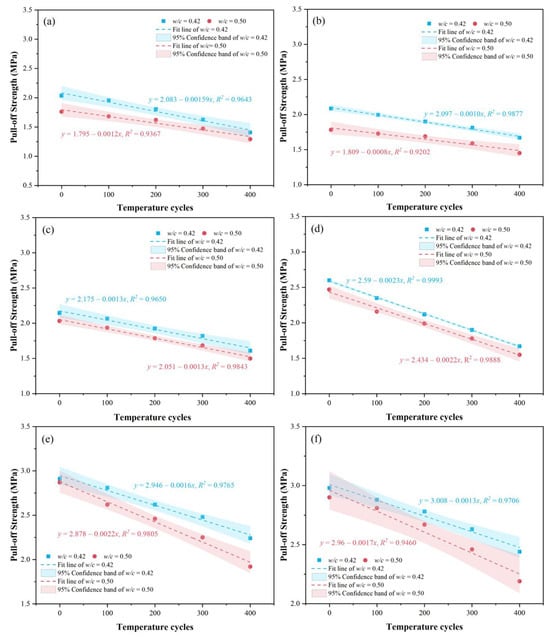
Figure 6.
The changes of pull-off strength of MSM and RSM with the increase in thermal cycles at different curing ages: (a) MSM curing for 0 days, (b) MSM curing for 3 days, (c) MSM curing for 7 days, (d) RSM curing for 0 days, (e) RSM curing for 3 days and (f) RSM curing for 7 days.
Aiming to analyze the influence of thermal cycling on the pull-off strength more accurately, the development of MSM and RSM bonding strength was further analyzed using a straight line fitting equation (y = a + bx). Referring to the calculation methods published in existing research [41], the test probabilities for each estimated parameter were <<0.05, indicating the statistical significance of the results. The fitting results are shown in Figure 6, and Table 3 presents the coefficients from the fitting equation in Figure 6. The a-value refers to the y-intercept of the line. This means that the a-value stands for the theoretical bonding strength of MSM subjected to 0 thermal cycles. As shown in Table 3, under the same water-cement ratio conditions, the longer the curing age, the higher the a-value. This is consistent with the study in the previous section. In addition, the coefficient b represents the rate of decrease in bonding strength. It can be seen from Table 3 that the absolute value of the b coefficient of the MSM is always lower than that of the RSM under the same curing time and water-cement ratio. This indicates that the effect of thermal cycling on RSM is higher than its effect on MSM. In other words, RSM is more susceptible to weathering than MSM. However, after comparing the data of the two kinds of mortars in Figure 6, it can be concluded that the bonding strength of RSM is always higher than the MSM when the same number of thermal cycles is experienced. This demonstrates that although the bonding strength of RSM is more affected by weathering, it is still higher than the bonding strength of MSM in the same environment. On the other hand, Table 3 shows that the fitness of each fitting equation is higher than 92%, which indicates that this equation can be used to simulate the effect of thermal cycling on the bonding strength. It is worth noting that the fitting results in this part are only applicable when the number of thermal cycles is under 400. If the number of thermal cycles continues to increase, a rapid decrease in the pull-out strength may be observed. The relationship between more thermal cycles and the thermal effects of real walls needs to be further discussed in subsequent studies [42].

Table 3.
Comparison of the fitting equations.
Figure 7 shows the percentage reduction in bonding strength of MSM and RSM compared to the initial value of 0 cycles after different numbers of cycles (100, 200, 300 and 400) of thermal cycling. As the number of thermal cycles increases, the percentage decrease in bonding strength increases continuously, and the rate of decrease continues to increase. After 400 cycles, the percentage decrease in MSM bonding strength exceeds 18%, and the highest decrease percentage reaches 30.86%. For MSM prepared with 0.42 w/c and cured for 0 days, 3 days and 7 days, the bonding strength reduction percentages were 30.86%, 19.98% and 24.91%, respectively, after 400 thermal cycles. Meanwhile, when the water-cement ratio was 0.50, the bonding strength decreased by 26.63%, 18.62% and 26.23% under the same conditions, respectively. For RSM prepared with a w/c of 0.45 and 0.50 cured for 0 days, 3 days and 7 days, the bonding strength decreased by 35.77%, 23.02% and 18.12% and 37.25%, 33.1% and 24.48%, respectively, after 400 cycles.
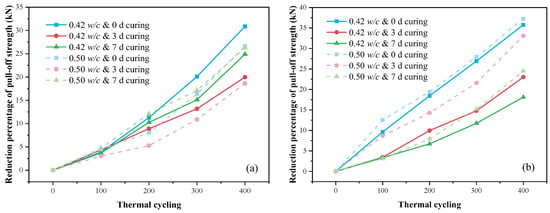
Figure 7.
The percentage of bonding strength decreases as the number of thermal cycles increases: (a) MSM and (b) RSM.
In addition, Figure 7b shows that the percent reduction in RSM bonding strength decreases as the mortar’s early curing time increases. This suggests that early curing is beneficial to RSM bonding strength under a weathering effect. Moreover, the RSM has a greater reduction in the bonding strength after experiencing different thermal cycles when the w/c is relatively high. This means that a higher water-cement ratio will cause the RSM to lose water in the weathering environment and form more pores, resulting in a decrease in bonding strength [12,43,44,45]. In contrast, for the MSM samples, it can be concluded that there is no direct relationship between curing time and the degradation of bonding strength under thermal cycling. In other words, under the same thermal cycling conditions, the bonding strength of samples with longer curing times will not vary proportionally. Therefore, in the case of the weathering effect, early curing does not appear to be the only dominant factor affecting the bonding strength. It is worth noting that after more than 200 thermal cycles, the MSM samples cured for 3 days had the lowest reduction in bonding strength. This phenomenon indicates that over-curing may be harmful to the development of MSM bonding strength in weathered environments.
4. Conclusions
In this study, manufactured sand was used to replace the natural river sand in mortar used in external wall tile structures. The effect of thermal cycling and curing age on the bonding strength of cement mortar using manufactured sand was explored.
When the water-cement ratio and curing age are constant, the compressive strength of MSM is always higher than that of RSM. However, under the same curing conditions, the bonding strength of RSM is always higher than that of MSM, indicating that its bonding strength is not proportional to the compressive strength of the mortar. The weathering effect will significantly reduce the bonding strength of the exterior wall structure, but under the same number of thermal cycles, the bonding strength of RSM is always higher than that of MSM, and the impact of thermal cycles on RSM is greater than that on MSM. After 400 cycles, the percentage decrease in the bonding strength of the MSM sample ranged from 18.62% to 30.86%. In addition, the degradation of MSM bonding strength under thermal cycling is not directly related to curing time, and excessive curing may be detrimental to the development of MSM bonding strength in weathered environments.
Author Contributions
Data curation, H.P., C.Z. and D.Z.; Formal analysis, W.Y. and H.Y.; Funding acquisition, H.C.; Methodology, H.C. and D.Z.; Validation, H.P.; Writing—original draft, H.Y.; Writing—review & editing, H.C., C.Z. and D.Z. All authors have read and agreed to the published version of the manuscript.
Funding
We sincerely appreciate the funding support from National Key Research and Development Program of China (No.: 2022YFC3800903) and Shenzhen Metro Group Co., Ltd. (No.: SZDT-JSZX-ZC-2020-0022).
Data Availability Statement
Data is contained within the article.
Conflicts of Interest
Authors Weiwei Yang and Chaohui Zhang were employed by the company Shenzhen Metro Group Co., Ltd. The remaining authors declare that the research was conducted in the absence of any commercial or financial relationships that could be construed as a potential conflict of interest.
References
- Mahaboonpachai, T.; Kuromiya, Y.; Matsumoto, T. Experimental investigation of adhesion failure of the interface between concrete and polymer-cement mortar in an external wall tile structure under a thermal load. Constr. Build. Mater. 2008, 22, 2001–2006. [Google Scholar] [CrossRef]
- Wetzel, A.; Zurbriggen, R.; Herwegh, M.; Greminger, A.; Kaufmann, J. Long-term study on failure mechanisms of exterior applied tilings. Constr. Build. Mater. 2012, 37, 335–348. [Google Scholar] [CrossRef]
- Zhang, Y.; Wu, K.; Zhang, S.; Kong, X.; Zhang, H.; Zhang, X. Numerical simulation on damage behaviors of tile-mortar interface induced by mortar shrinkage and temperature cycles. Eng. Fail. Anal. 2023, 148, 107169. [Google Scholar] [CrossRef]
- Chew, M.Y.L. The study of adhesion failure of wall tiles. Build. Environ. 1992, 27, 493–499. [Google Scholar] [CrossRef]
- Chew, M.Y.L. Factors affecting ceramic tile adhesion for external cladding. Constr. Build. Mater. 1999, 13, 293–296. [Google Scholar] [CrossRef]
- Ozkahraman, H.T.; Işık, E.C. The effect of chemical and mineralogical composition of aggregates on tensile adhesion strength of tiles. Constr. Build. Mater. 2005, 19, 251–255. [Google Scholar] [CrossRef]
- Mahaboonpachai, T.; Matsumoto, T.; Inaba, Y. Investigation of interfacial fracture toughness between concrete and adhesive mortar in an external wall tile structure. Int. J. Adhes. Adhes. 2010, 30, 1–9. [Google Scholar] [CrossRef]
- Andiç, Ö.; Ramyar, K.; Korkut, Ö. Effect of fly ash addition on the mechanical properties of tile adhesive. Constr. Build. Mater. 2005, 19, 564–569. [Google Scholar] [CrossRef]
- Jenni, A.; Holzer, L.; Zurbriggen, R.; Herwegh, M. Influence of polymers on microstructure and adhesive strength of cementitious tile adhesive mortars. Cem. Concr. Res. 2005, 35, 35–50. [Google Scholar] [CrossRef]
- Mahaboonpachai, T.M.T. Investigation of interfacial resistance between concrete and polymer-cement mortar and development of constitutive material model for the interface. J. Appl. Mech. 2005, 8, 977–985. [Google Scholar] [CrossRef]
- Rumbayan, T.M.R.; Matsumoto, T. Thermographic measurement and thermal stress analysis at the interface of external wall tile structure. J. Appl. Mech. 2006, 9, 1069–1076. [Google Scholar] [CrossRef]
- Nilimaa, J.; Hösthagen, A.; Emborg, M. Thermal Crack Risk of Concrete Structures: Evaluation of Theoretical Models for Tunnels and Bridges. Nord. Concr. Res. 2017, 56, 55–69. [Google Scholar]
- Bochen, J. Weathering effects on physical-chemical properties of external plaster mortars exposed to different environments. Constr. Build. Mater. 2015, 79, 192–206. [Google Scholar] [CrossRef]
- Shen, W.; Liu, Y.; Cao, L.; Huo, X.; Yang, Z.; Zhou, C.; He, P.; Lu, Z. Mixing design and microstructure of ultra high strength concrete with manufactured sand. Constr. Build. Mater. 2017, 143, 312–321. [Google Scholar] [CrossRef]
- Ke, G.; Zhou, M. Influence of manufactured sand characteristics on strength and abrasion resistance of pavement cement concrete. Constr. Build. Mater. 2011, 25, 3849–3853. [Google Scholar]
- Wang, J.; Zhou, M. Effect of limestone fines content in manufactured sand on durability of low- and high-strength concretes. Constr. Build. Mater. 2009, 23, 2846–2850. [Google Scholar]
- Ji, T.; Chen, C.-Y.; Zhuang, Y.-Z.; Chen, J.-F. A mix proportion design method of manufactured sand concrete based on minimum paste theory. Constr. Build. Mater. 2013, 44, 422–426. [Google Scholar] [CrossRef]
- Shen, W.; Yang, Z.; Cao, L.; Cao, L.; Liu, Y.; Yang, H.; Lu, Z.; Bai, J. Characterization of manufactured sand: Particle shape, surface texture and behavior in concrete. Constr. Build. Mater. 2016, 114, 595–601. [Google Scholar] [CrossRef]
- Zhang, M.T.X. Discussion of "Particle Shape Effects on Packing Density, Stiffness, and Strength Natural and Crushed Sands" by Gye-Chun Cho, Jake Dodds, and J. Carlos Santamarina 2007, 132, 553–561. [Google Scholar]
- Gonçalves, J.P.; Tavares, L.M.; Filho, R.D.T.; Fairbairn, E.M.R.; Cunha, E.R. Comparison of natural and manufactured fine aggregates in cement mortars. Cem. Concr. Res. 2007, 37, 924–932. [Google Scholar] [CrossRef]
- Cepuritis, R.; Wigum, B.J.; Garboczi, E.J.; Mørtsell, E.; Jacobsen, S. Filler from crushed aggregate for concrete: Pore structure, specific surface, particle shape and size distribution. Cem. Concr. Compos. 2014, 54, 2–16. [Google Scholar] [CrossRef]
- Imamoto, K.; Arai, M. Specific surface area of aggregate and its relation to concrete drying shrinkage. Mater. Struct. 2007, 41, 323–333. [Google Scholar] [CrossRef]
- Nanthagopalan, P.; Santhanam, M. Fresh and hardened properties of self-compacting concrete produced with manufactured sand. Cem. Concr. Compos. 2011, 33, 353–358. [Google Scholar] [CrossRef]
- Jamkar, S.S.; Rao, C.B.K. Index of Aggregate Particle Shape and Texture of coarse aggregate as a parameter for concrete mix proportioning. Cem. Concr. Res. 2004, 34, 2021–2027. [Google Scholar] [CrossRef]
- Westerholm, M. Rheology of the mortar phase of concrete with crushed aggregate. Ph.D. Dissertation, Luleå Tekniska Universitet, Luleå, Sweden, 2006. [Google Scholar]
- Shen, W.; Liu, Y.; Wang, Z.; Cao, L.; Wu, D.; Wang, Y.; Ji, X. Influence of manufactured sand’s characteristics on its concrete performance. Constr. Build. Mater. 2018, 172, 574–583. [Google Scholar] [CrossRef]
- Ji, T.; Chen, B.C.; Zhuang, Y.Z.; Li, F.; Huang, Z.B.; Liang, Y.N. Effects of Sand Particle Size and Gradation on Strength of Reactive Powder Concrete. Adv. Mater. Res. 2011, 261–263, 208–211. [Google Scholar] [CrossRef]
- Donza, H.; Irassar, E.F. High-strength concrete with different fine aggregate. Cem. Concr. Res. 2002, 32, 1755–1761. [Google Scholar] [CrossRef]
- Lim, S.K.; Tan, C.S.; Chen, K.P.; Lee, M.L.; Lee, W.P. Effect of different sand grading on strength properties of cement grout. Constr. Build. Mater. 2013, 38, 348–355. [Google Scholar] [CrossRef]
- HK Construction Standard CS3_2013_updated with amendments; The Government of the Hong Kong Special Administrative Region: Hong Kong, 2013; pp. 51–56.
- Yoo, D.Y.; Kim, S.; Kim, J.J.; Chun, B. An experimental study on pullout and tensile behavior of ultra-high-performance concrete reinforced with various steel fibers. Constr. Build. Mater. 2019, 206, 46–61. [Google Scholar] [CrossRef]
- Sadowski, Ł.; Hoła, J.; Czarnecki, S.; Wang, D. Pull-off adhesion prediction of variable thick overlay to the substrate. Autom. Constr. 2018, 85, 10–23. [Google Scholar] [CrossRef]
- Szemerey-Kiss, B.; Török, Á. Failure mechanisms of repair mortar stone interface assessed by pull-off strength tests. Bull. Eng. Geol. Environ. 2016, 76, 159–167. [Google Scholar] [CrossRef]
- Singh, S.B.; Munjal, P.; Thammishetti, N. Role of water/cement ratio on strength development of cement mortar. J. Build. Eng. 2015, 4, 94–100. [Google Scholar] [CrossRef]
- Bonavetti, V.; Donza, H.; Menéndez, G.; Cabrera, O.; Irassar, E.F. Limestone filler cement in low w/c concrete: A rational use of energy. Cem. Concr. Res. 2003, 33, 865–871. [Google Scholar] [CrossRef]
- Joudi-Bahri, I.; Lecomte, A.; Ouezdou, M.B.; Achour, T. Use of limestone sands and fillers in concrete without superplasticizer. Cem. Concr. Compos. 2012, 34, 771–780. [Google Scholar] [CrossRef]
- Neville, A.M. Properties of Concrete. Fourth and Final Edition Standards; Prentice Hall Pearson: Hoboken, NJ, USA, 1996. [Google Scholar]
- Geng, Z.; Tang, S.; Wang, Y.; He, Z.; Wu, K. The stress relaxation properties of calcium silicate hydrate: A molecular dynamics study. J. Zhejiang Univ. A 2024, 25, 97–115. [Google Scholar] [CrossRef]
- Zain, M.F.b.H.M. The Study on the Physical Properties of Surface Layer Concrete under the Influence of Medium Temperature Environments. Ph.D. Thesis, Kyushu University, Fukuoka, Japan, 1996. [Google Scholar]
- Dias, C.M.R.; Cincotto, M.A.; Savastano, H.; John, V.M. Long-term aging of fiber-cement corrugated sheets—The effect of carbonation, leaching and acid rain. Cem. Concr. Compos. 2008, 30, 255–265. [Google Scholar] [CrossRef]
- Ślusarek, J.; Nowoświat, A.; Olechowska, M. Logistic model of phase transformation of hardening concrete. Materials 2022, 15, 4403. [Google Scholar] [CrossRef] [PubMed]
- Nilimaa, J.; Zhaka, V. An Overview of Smart Materials and Technologies for Concrete Construction in Cold Weather. Eng 2023, 4, 1550–1580. [Google Scholar] [CrossRef]
- Liao, Y.; Wang, S.; Wang, K.; Qunaynah, S.A.; Wan, S.; Yuan, Z.; Xu, P.; Tang, S. A study on the hydration of calcium aluminate cement pastes containing silica fume using non-contact electrical resistivity measurement. J. Mater. Res. Technol. 2023, 24, 8135–8149. [Google Scholar] [CrossRef]
- Liao, Y.; Yao, J.; Deng, F.; Li, H.; Wang, K.; Tang, S. Hydration behavior and strength development of supersulfated cement prepared by calcined phosphogypsum and slaked lime. J. Build. Eng. 2023, 80, 108075. [Google Scholar] [CrossRef]
- Tang, S.; Cai, R.; He, Z.; Cai, X.; Shao, H.; Li, Z.; Yang, H.; Chen, E. Continuous microstructural correlation of slag/superplasticizer cement pastes by heat and impedance methods via fractal analysis. Fractals 2017, 25, 1740003. [Google Scholar] [CrossRef]
Disclaimer/Publisher’s Note: The statements, opinions and data contained in all publications are solely those of the individual author(s) and contributor(s) and not of MDPI and/or the editor(s). MDPI and/or the editor(s) disclaim responsibility for any injury to people or property resulting from any ideas, methods, instructions or products referred to in the content. |
© 2024 by the authors. Licensee MDPI, Basel, Switzerland. This article is an open access article distributed under the terms and conditions of the Creative Commons Attribution (CC BY) license (https://creativecommons.org/licenses/by/4.0/).